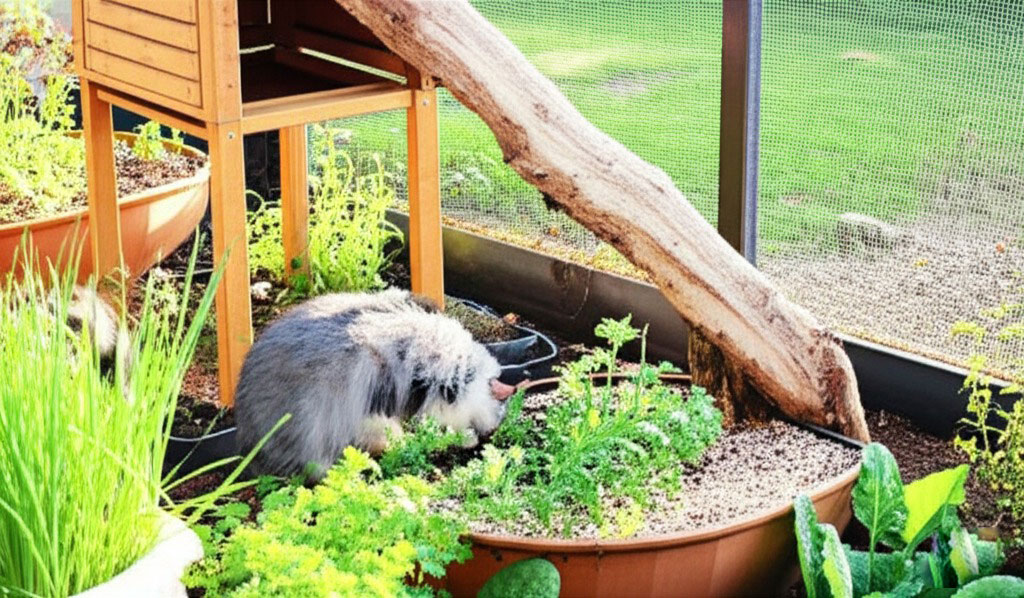Why Your Cat Needs a Garden
If Whiskers is nibbling on your zinnias or rolling around in the dirt next to your tomato plant, it may be time for a garden of his own.
Providing your feline friend with an edible garden has a variety of benefits. A garden offers your cat a special place where he can enjoy fresh air and sunshine while nibbling on a variety of vitamin and mineral-rich plants.
“Providing a secure outdoor garden is a valuable part of good cat care,” says Dori Slater, a veterinarian who has an enclosed garden for her four indoor cats. “Cats love to sleep among the plants, play and watch the world go by. A garden relieves boredom, especially if the owner is away at work all day.”
Health Benefits of a Cat Garden
An outdoor garden provides several health advantages:
- Natural sunlight stimulates vitamin D production for healthy bones.
- Daily exposure to light and dark supports normal neuroendocrine functions.
- Access to fresh air and stimulation can reduce boredom and stress.
Nutritious Plants Cats Love
Many plants cats enjoy are packed with nutrients:
- Parsley: Vitamins A, B, C, beta carotene, and potassium.
- Carrot tops: Vitamin A and beta carotene.
- Spinach: High in calcium and vitamins C and A.
Cat-Friendly Plants to Grow
In addition to vegetables, try these plants:
- Zinnias
- Marigolds
- Johnny-jump-ups
- Catnip (test first, not all cats enjoy it)
- Cat thyme
- Oat grass (a favorite for most cats)
- Rosemary
- Bean sprouts
“Oat grass is gentle on a cat’s digestive system and less likely to cause vomiting,” says Slater.
Starting a Cat Garden from Seed
Growing from seed is budget-friendly and safer since you control chemical exposure.
Mary Lou Heard recommends this soil mix:
- 1/3 potting soil
- 1/3 peat moss
- 1/3 vermiculite
Water gently with a fine mist or from the bottom. Cover seeds with peat moss outdoors to protect from birds. Place containers in partial light and avoid letting seeds dry out.
Speeding Up Germination
Create a humidity chamber by placing the container in a sealed plastic bag. Remove the bag once seedlings emerge to prevent fungus.
Germination times:
- Parsley: 2–5 weeks
- Carrots: 1–3 weeks (pre-soak seeds to speed up)
- Oat grass: A few days
- Catnip and spinach: About a week
- Rosemary and cat thyme: Usually grown from cuttings
Slater recommends reseeding oat grass every 2–3 weeks for a steady supply.
Managing Catnip
Have two containers of catnip so one can rejuvenate while the other is in use. “Catnip will come back to life. Just cut out the bad parts and give it time,” says Heard.
Plants to Avoid
Some plants are toxic to cats. Avoid:
- Oleander
- Poinsettias
- Yew
- Lily of the valley
- Philodendron
- Azalea
- Sweet pea
- Jimson weed
- Dieffenbachia
- Large-leaf ivy
- Mistletoe
- Cherry
- Morning glory
- Iris
- Mushrooms
- Rhubarb leaves
Also avoid any plant that produces foxtails, as these can cause medical issues if ingested or embedded in the body.
Safe Fertilizers and Pest Control
- Use natural fertilizers like blood meal, bone meal, fish emulsion, and kelp.
- Avoid chemical or systemic fertilizers.
- For pests like aphids, use water sprays or insecticidal soap and remove affected parts manually.
Avoid chemical pesticides. Slater warns that some, like Snarol pellets, resemble cat food and can be fatal.
Creating a Cat Garden in Small Spaces
Even a small space can become a cat haven:
- Use side walkways, balconies, or patios.
- Install a cat door and create access to a container garden.
- Consider a window box garden with access to fresh air and sunlight.
Cat Garden Enhancements
Make the space more fun and functional with:
- Enclosures made from PVC pipe and wire (no gaps larger than 2 inches)
- Fruit tree branches for climbing
- Scratching posts or cat condos
- Wicker baskets for sleeping
- Mobiles or a nightlight to attract bugs
Place the garden where it receives both sunlight and shade, and is sheltered from strong winds.

